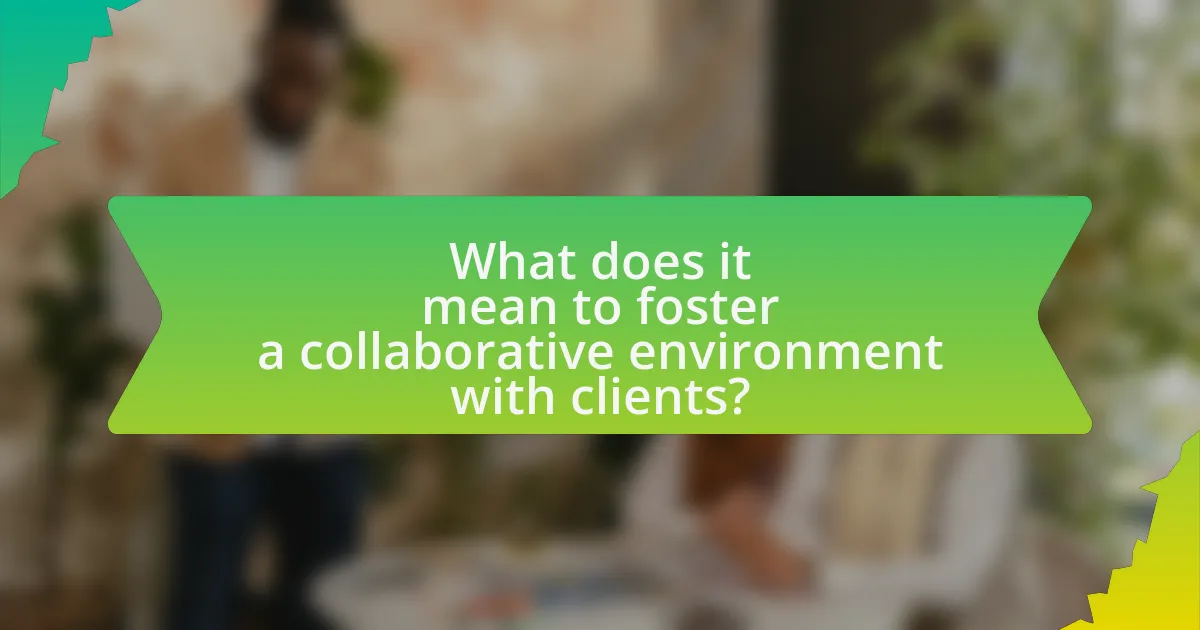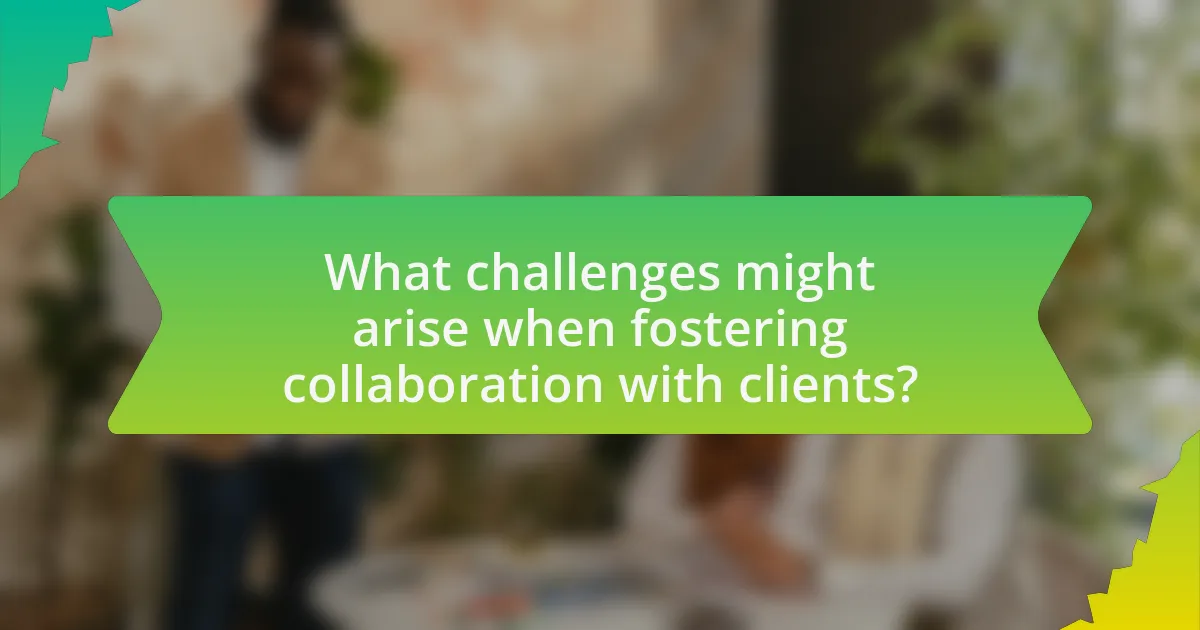The article focuses on fostering a collaborative environment with clients, emphasizing the importance of open communication, mutual respect, and shared goals. It outlines how collaboration enhances client relationships, improves project outcomes, and increases client satisfaction and loyalty. Key elements of a collaborative environment, such as effective communication and trust, are discussed alongside strategies for implementation, including setting clear expectations and utilizing technology. The article also addresses potential challenges in collaboration and offers best practices for maintaining a productive and harmonious working relationship with clients.

What does it mean to foster a collaborative environment with clients?
Fostering a collaborative environment with clients means creating a space where open communication, mutual respect, and shared goals are prioritized. This approach encourages active participation from both parties, leading to better understanding and alignment on project objectives. Research indicates that organizations that emphasize collaboration can achieve up to 5 times higher performance levels, as collaboration enhances problem-solving and innovation. By establishing trust and facilitating regular feedback, businesses can ensure that client input is valued, ultimately resulting in more successful outcomes.
How can collaboration enhance client relationships?
Collaboration enhances client relationships by fostering trust and open communication. When clients and service providers work together, they can share insights and feedback, leading to a deeper understanding of client needs and preferences. This joint effort often results in tailored solutions that meet specific requirements, thereby increasing client satisfaction. Research indicates that companies with high levels of collaboration experience a 20% increase in customer satisfaction scores, demonstrating the tangible benefits of cooperative engagement.
What are the key elements of a collaborative environment?
The key elements of a collaborative environment include open communication, mutual respect, shared goals, trust, and active participation. Open communication ensures that all team members can express their ideas and concerns freely, fostering transparency. Mutual respect among participants encourages diverse perspectives and enhances teamwork. Shared goals align the efforts of all individuals towards a common objective, increasing motivation and focus. Trust is essential for team members to rely on one another, facilitating risk-taking and innovation. Active participation involves engaging all members in discussions and decision-making processes, which enhances commitment and accountability. These elements collectively create a productive and harmonious collaborative environment.
How does effective communication play a role in collaboration?
Effective communication is essential for successful collaboration as it ensures clarity, alignment, and mutual understanding among team members. When individuals communicate effectively, they can share ideas, provide feedback, and resolve conflicts more efficiently, which enhances teamwork. Research indicates that teams with strong communication practices are 25% more productive, as they can coordinate tasks and share information seamlessly, leading to better outcomes. Furthermore, effective communication fosters trust and rapport, which are critical components of a collaborative environment, enabling clients and teams to work together more harmoniously.
Why is fostering collaboration important for business success?
Fostering collaboration is crucial for business success because it enhances innovation and problem-solving capabilities. When teams collaborate effectively, they combine diverse perspectives and skills, leading to more creative solutions and improved decision-making. Research from the Institute for Corporate Productivity indicates that organizations with high collaboration levels are 5 times more likely to be high-performing. This demonstrates that collaboration not only drives efficiency but also significantly contributes to achieving strategic goals and maintaining a competitive edge in the market.
What impact does collaboration have on project outcomes?
Collaboration significantly enhances project outcomes by improving communication, increasing innovation, and fostering a sense of ownership among team members. Effective collaboration leads to better problem-solving as diverse perspectives are integrated, which can result in more creative solutions. Research indicates that projects with high collaboration levels are 5 times more likely to achieve their goals, as reported in the Project Management Institute’s “Pulse of the Profession” report. This demonstrates that collaboration not only streamlines processes but also boosts overall project success rates.
How does collaboration influence client satisfaction and loyalty?
Collaboration significantly enhances client satisfaction and loyalty by fostering open communication and trust. When clients are actively involved in the decision-making process, they feel valued and heard, which leads to a stronger emotional connection with the service provider. Research indicates that companies with high levels of collaboration report a 20% increase in customer satisfaction scores, as clients appreciate transparency and responsiveness. Furthermore, a study by the Harvard Business Review found that organizations that prioritize collaborative relationships with clients experience a 30% increase in client retention rates, demonstrating that effective collaboration directly correlates with long-term loyalty.

What strategies can be implemented to foster collaboration with clients?
To foster collaboration with clients, organizations can implement strategies such as establishing clear communication channels, setting shared goals, and utilizing collaborative tools. Clear communication channels, including regular check-ins and feedback loops, ensure that both parties are aligned and can address issues promptly. Setting shared goals creates a sense of partnership and accountability, motivating both the organization and the client to work towards common objectives. Utilizing collaborative tools, such as project management software and shared documents, enhances transparency and facilitates real-time collaboration. These strategies are supported by research indicating that effective communication and shared objectives significantly improve client satisfaction and project outcomes.
How can setting clear expectations improve collaboration?
Setting clear expectations significantly improves collaboration by ensuring all parties understand their roles, responsibilities, and objectives. When expectations are explicitly defined, team members can align their efforts towards common goals, reducing misunderstandings and conflicts. Research indicates that teams with well-defined expectations experience a 25% increase in productivity, as members are more focused and accountable for their tasks. This clarity fosters trust and open communication, essential elements for effective collaboration, ultimately leading to better project outcomes and stronger client relationships.
What are the best practices for establishing mutual goals?
The best practices for establishing mutual goals include open communication, active listening, and collaborative brainstorming. Open communication ensures that all parties express their needs and expectations clearly, fostering transparency. Active listening allows participants to understand each other’s perspectives, which is crucial for aligning interests. Collaborative brainstorming encourages creative solutions that satisfy all stakeholders, leading to shared ownership of the goals. Research indicates that organizations that prioritize these practices experience higher levels of engagement and satisfaction, as evidenced by a study published in the Journal of Business Research, which found that effective communication and collaboration significantly enhance goal alignment and project success.
How can regular feedback sessions enhance the collaborative process?
Regular feedback sessions enhance the collaborative process by facilitating open communication and continuous improvement among team members. These sessions allow participants to share insights, address challenges, and align their goals, which fosters a sense of shared ownership and accountability. Research indicates that teams that engage in regular feedback are 25% more productive, as they can quickly adapt to changes and refine their strategies based on real-time input. This iterative approach not only strengthens relationships but also leads to higher quality outcomes, as team members feel valued and empowered to contribute their perspectives.
What role does technology play in fostering collaboration?
Technology plays a crucial role in fostering collaboration by providing tools that enhance communication and streamline workflows. These tools, such as video conferencing platforms, project management software, and collaborative document editing, enable teams to connect in real-time, share information seamlessly, and coordinate tasks effectively. For instance, a study by McKinsey found that productivity improves by 20-25% in organizations that use social technologies to facilitate collaboration. This demonstrates that technology not only supports but actively enhances collaborative efforts among clients and teams.
Which tools are most effective for facilitating client collaboration?
Effective tools for facilitating client collaboration include Slack, Microsoft Teams, and Trello. Slack enables real-time communication and file sharing, enhancing team interaction and client engagement. Microsoft Teams integrates chat, video conferencing, and document collaboration, making it suitable for comprehensive project management. Trello offers a visual task management system that allows clients to track project progress and collaborate on tasks efficiently. These tools are widely adopted in various industries, demonstrating their effectiveness in improving communication and collaboration between clients and teams.
How can virtual meetings enhance client engagement?
Virtual meetings enhance client engagement by facilitating real-time communication and interaction, which fosters a sense of connection and collaboration. These platforms allow for immediate feedback, enabling clients to express their thoughts and concerns directly, thus increasing their involvement in discussions. Research indicates that 70% of clients prefer virtual meetings for their convenience and accessibility, which can lead to higher satisfaction and retention rates. Additionally, visual elements such as screen sharing and presentations during virtual meetings can help clarify complex information, making it easier for clients to understand and engage with the content being discussed.

What challenges might arise when fostering collaboration with clients?
Challenges that might arise when fostering collaboration with clients include miscommunication, differing expectations, and resistance to change. Miscommunication can lead to misunderstandings about project goals and deliverables, which can hinder progress. Differing expectations may arise when clients have a vision that does not align with the service provider’s capabilities or approach, resulting in dissatisfaction. Resistance to change can occur when clients are hesitant to adopt new processes or technologies, which can stall collaborative efforts. These challenges are supported by research indicating that effective communication and alignment of goals are critical for successful collaboration (Project Management Institute, 2021).
How can differing expectations hinder collaboration?
Differing expectations can hinder collaboration by creating misunderstandings and conflicts among team members. When individuals or groups have varying assumptions about goals, roles, or outcomes, it leads to misalignment in efforts and priorities. For instance, a study by the Project Management Institute found that 37% of project failures are attributed to a lack of clarity in project objectives, which often stems from differing expectations. This misalignment can result in decreased motivation, reduced trust, and ultimately, project delays or failures, as team members may work at cross purposes rather than collaboratively towards a shared goal.
What strategies can be used to align client and provider goals?
To align client and provider goals, effective communication and collaborative planning are essential strategies. Establishing regular check-ins allows both parties to discuss expectations and progress, ensuring that goals remain aligned throughout the project. Additionally, utilizing shared metrics for success fosters transparency and accountability, enabling both clients and providers to track their objectives collectively. Research indicates that organizations that prioritize collaborative goal-setting experience a 20% increase in project success rates, demonstrating the effectiveness of these strategies in achieving mutual objectives.
How can misunderstandings be minimized during collaboration?
Misunderstandings can be minimized during collaboration by establishing clear communication protocols. Clear communication ensures that all parties understand their roles, expectations, and objectives, which reduces ambiguity. Research indicates that effective communication can lead to a 25% increase in project success rates, as highlighted in the Project Management Institute’s “Pulse of the Profession” report. Regular check-ins and feedback loops further enhance understanding and alignment among team members, fostering a collaborative environment.
What are common pitfalls to avoid in client collaboration?
Common pitfalls to avoid in client collaboration include poor communication, lack of clarity in expectations, and insufficient feedback mechanisms. Poor communication can lead to misunderstandings and misaligned goals, as evidenced by a study from the Project Management Institute, which found that ineffective communication is a primary cause of project failure in 56% of cases. Lack of clarity in expectations can result in unmet deliverables and dissatisfaction, highlighting the importance of setting clear objectives from the outset. Insufficient feedback mechanisms can hinder progress and improvement, as continuous feedback is essential for adapting to client needs and ensuring alignment throughout the collaboration process.
How can over-communication negatively impact collaboration?
Over-communication can negatively impact collaboration by creating confusion and information overload among team members. When excessive messages are sent, individuals may struggle to prioritize important information, leading to misunderstandings and decreased productivity. Research indicates that teams experiencing information overload report a 30% drop in efficiency, as members spend more time sifting through irrelevant communications rather than focusing on their tasks. This disruption can hinder effective collaboration, as clarity and focus are essential for successful teamwork.
What are the risks of underestimating client input?
Underestimating client input can lead to significant risks, including project misalignment, decreased client satisfaction, and potential financial losses. When client feedback is undervalued, the final deliverables may not meet their expectations, resulting in a disconnect between the client’s vision and the project’s outcome. Research indicates that projects with high client involvement are 30% more likely to succeed, highlighting the importance of integrating client perspectives. Additionally, ignoring client input can damage the relationship, leading to a lack of trust and future collaboration opportunities.
What are the best practices for maintaining a collaborative environment?
The best practices for maintaining a collaborative environment include fostering open communication, establishing clear roles and responsibilities, and encouraging mutual respect among team members. Open communication ensures that all participants feel comfortable sharing ideas and feedback, which enhances collaboration. Establishing clear roles and responsibilities helps to avoid confusion and overlap, allowing team members to focus on their specific contributions. Encouraging mutual respect creates a positive atmosphere where diverse perspectives are valued, leading to more innovative solutions. Research by the Institute for Corporate Productivity indicates that organizations with strong collaborative cultures are 5 times more likely to be high-performing, highlighting the importance of these practices in achieving successful collaboration.
How can ongoing relationship building support collaboration?
Ongoing relationship building supports collaboration by fostering trust and open communication among team members. Trust enhances the willingness to share ideas and resources, which is essential for effective collaboration. Research indicates that teams with strong interpersonal relationships are 50% more likely to achieve their goals, as they can navigate conflicts and leverage diverse perspectives more effectively. Furthermore, continuous engagement allows for the alignment of objectives and expectations, ensuring that all parties are working towards a common goal, thereby increasing overall productivity and innovation.
What techniques can be used to celebrate collaborative successes?
Techniques to celebrate collaborative successes include recognition ceremonies, team-building activities, and public acknowledgments. Recognition ceremonies can involve awards or certificates that highlight individual and team contributions, fostering a sense of achievement. Team-building activities, such as group outings or workshops, can strengthen relationships and reinforce the collaborative spirit. Public acknowledgments, whether through newsletters, social media, or company meetings, can enhance visibility and appreciation for the team’s efforts. These methods are effective as they not only celebrate achievements but also motivate continued collaboration and engagement among team members.


